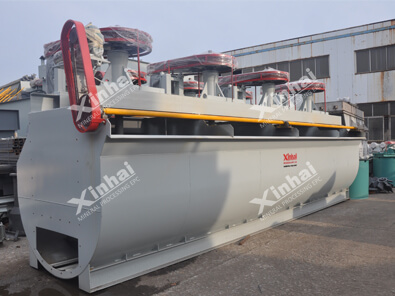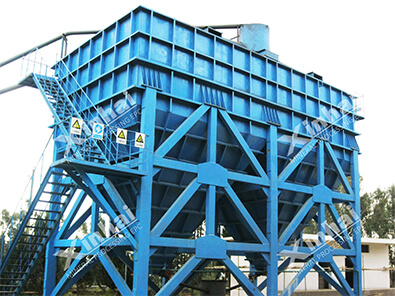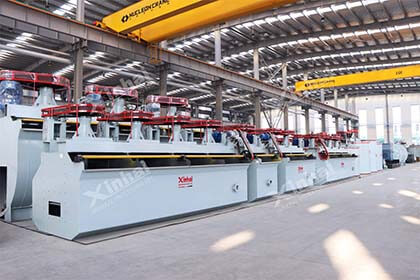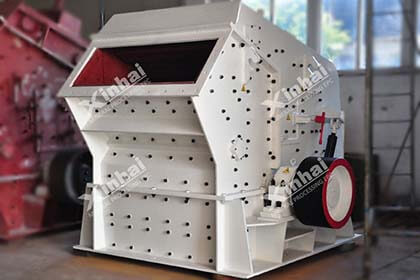Rare Earth Processing: Unlocking the Potential of Precious Elements
 Essow
Essow
 Jan 23, 2024
Jan 23, 2024
 1259
1259
If you want to know more details about equipment, solutions, etc, please click the button below for free consultation, or leave your requirements!
Rare earth elements (REEs) are a group of 17 chemically similar elements that play a crucial role in various modern technologies. From smartphones and electric vehicles to renewable energy systems, rare earth elements are essential components. This article explores the process of rare earth processing, shedding light on the extraction, refining, and applications of these valuable elements.
01 Understanding Rare Earth Elements
BackThis section provides an overview of rare earth elements, their properties, and significance. It discusses the unique characteristics of REEs that make them vital in manufacturing high-tech products and their scarcity in the Earth's crust. The section also highlights the geopolitical implications of rare earth elements and the need to secure a sustainable supply chain.
Rare earth elements (REEs) are a group of 17 chemically similar elements that occupy the lanthanide series of the periodic table. The group includes elements such as lanthanum, cerium, praseodymium, neodymium, promethium, samarium, europium, gadolinium, terbium, dysprosium, holmium, erbium, thulium, ytterbium, lutetium, and two additional elements, scandium and yttrium. Despite their name, rare earth elements are not actually rare in the Earth's crust, but they are dispersed and not often found in high concentrations.
1. Properties of Rare Earth Elements
Rare earth elements possess unique physical and chemical properties that make them valuable in various industrial applications. They exhibit high magnetic strength, exceptional luminescence properties, and excellent catalytic capabilities. Additionally, REEs have high melting points, good thermal conductivity, and can withstand extreme conditions, making them suitable for use in diverse technological applications.
2. Significance of Rare Earth Elements
Rare earth elements have become indispensable in numerous modern technologies. They are vital components in the manufacturing of electronics, telecommunications equipment, energy-efficient lighting, permanent magnets, catalysts, rechargeable batteries, and many other advanced applications. For example, neodymium and dysprosium are critical for the production of powerful magnets used in electric vehicle motors and wind turbines. Cerium is used in automotive catalytic converters to reduce emissions, while europium and terbium are essential for producing vibrant colors in display screens and lighting.
3. Geopolitical Implications
The global supply of rare earth elements is currently dominated by a few countries, primarily China. This concentration of production raises concerns about the geopolitical implications and potential supply chain vulnerabilities. As rare earth elements have become increasingly critical for advanced technologies, efforts are being made to diversify the sources of supply and promote sustainable mining practices in other regions.
4. Sustainable Supply Chain
To ensure a sustainable supply chain of rare earth elements, several strategies are being pursued. These include recycling and recovery of REEs from electronic waste and other sources, developing alternative materials with similar properties, exploring new mining projects outside of China, improving processing technologies to reduce environmental impacts, and fostering international collaborations for resource exploration and production.
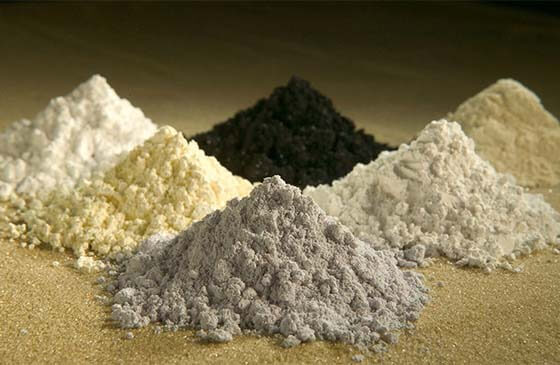
(Rare Earths)
02 Extraction of Rare Earth Elements
BackThe extraction of rare earth elements (REEs) involves several steps to separate these elements from the surrounding minerals. Here are some key points regarding the extraction process:
1. Mining Methods
Rare earth elements are typically found in low concentrations within complex mineral deposits. The primary methods used for mining REEs include open-pit mining, underground mining, and in-situ leaching.
Open-pit Mining: This method involves the excavation of ore from the surface, where the mineral deposit is located. It is commonly used when the deposit is near the surface and extends over a large area.
Underground Mining: In cases where the rare earth deposit is located at significant depths, underground mining is employed. It involves the construction of tunnels and shafts to access the ore and extract it.
In-situ Leaching: This method is used for rare earth deposits that are too deep or too difficult to mine conventionally. It involves injecting a leaching solution into the ore deposit to dissolve the rare earth elements, which are then brought to the surface for further processing.
2. Ore Processing
Once the ore is mined, it undergoes several stages of processing to separate the rare earth elements from other minerals and impurities. The specific techniques employed may vary depending on the mineralogy of the ore deposit. Common ore processing methods include:
Crushing and Grinding: The mined ore is crushed and ground into smaller particles to increase the surface area and facilitate subsequent processing.
Froth Flotation: This technique is often used to separate rare earth minerals from other minerals. It involves the addition of specific reagents that selectively bind to the rare earth minerals, allowing them to be separated from the rest of the ore through froth flotation.
Magnetic Separation: Magnetic separation is employed to separate magnetic rare earth minerals from non-magnetic minerals. By applying a magnetic field to the ore mixture, the magnetic minerals can be attracted and separated from the non-magnetic components.
Acid Leaching: Acid leaching is used to dissolve the rare earth elements from the ore. The ore is treated with acid, typically sulfuric acid, to extract the desired elements into a solution.
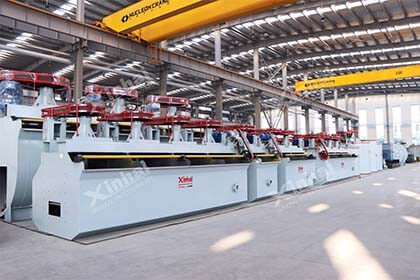
(Flotation Machines)
3. Refining and Separation
After the rare earth elements are extracted from the ore, further refining and separation processes are employed to obtain individual rare earth compounds of high purity. Some common separation techniques include:
Solvent Extraction: Solvent extraction is a widely used method for separating and purifying rare earth elements. It involves the use of organic solvents that selectively extract and separate the elements based on their chemical properties.
Ion Exchange: Ion exchange is another technique used for separating rare earth elements. It involves passing the rare earth solution through a resin that selectively adsorbs the elements based on their ionic properties.
4. Environmental Considerations
The extraction and processing of rare earth elements can have environmental impacts. Mining operations can cause habitat disruption, soil erosion, and water pollution if not properly managed. Additionally, the processing methods may produce waste materials that require careful handling and disposal to minimize environmental harm. It is crucial to implement responsible mining practices and adopt technologies that reduce environmental impacts throughout the extraction and processing stages.
03 Refining and Separation Techniques
BackOnce the rare earth elements (REEs) are extracted from the ore, further refining and separation processes are employed to obtain individual rare earth compounds of high purity. Here are some commonly used techniques in the refining and separation of REEs:
1. Solvent Extraction
Solvent extraction is a widely used method for separating and purifying rare earth elements. It involves the use of organic solvents that selectively extract and separate the elements based on their chemical properties. The process typically consists of the following steps:
Leaching: The rare earth elements are first dissolved in an acid solution, such as sulfuric acid, to create a leachate.
Extraction: The leachate is mixed with an organic solvent, such as an organic phosphoric acid, which selectively extracts the rare earth elements from the solution. The organic phase containing the desired elements is separated from the aqueous phase.
Stripping: The rare earth elements are then stripped from the organic phase using a stripping agent, typically an acid solution. This step allows for the recovery of the rare earth elements in a concentrated form.
Scrubbing: To ensure high-purity separation, a scrubbing step may be included to remove impurities that may have co-extracted with the rare earth elements during the extraction process.
2. Ion Exchange
Ion exchange is another commonly used technique for separating and purifying rare earth elements. It involves passing the rare earth solution through a resin that selectively adsorbs the elements based on their ionic properties. The process typically involves the following steps:
Loading: The rare earth solution is passed through an ion exchange resin. The resin has functional groups that selectively attract and bind the rare earth ions, separating them from other ions present in the solution.
Washing: After loading the rare earth ions onto the resin, a washing step is performed to remove any remaining impurities or unwanted ions.
Elution: The rare earth ions are then eluted from the resin using a suitable eluent, typically a strong acid or a complexing agent. This step allows for the recovery of the rare earth elements in a purified form.
3. Precipitation
Precipitation is used as a purification step to further refine the rare earth elements obtained from solvent extraction or ion exchange. The technique involves the controlled addition of a precipitating agent to the solution containing the rare earth elements, causing them to form insoluble compounds. The precipitates are then separated from the solution through filtration or centrifugation. This process helps eliminate impurities and obtain higher purity rare earth compounds.
4. Electrowinning
Electrowinning is an electrochemical technique used to separate and recover rare earth elements from a solution. It involves the use of an electric current to induce the deposition of the rare earth elements onto an electrode. The rare earth ions in the solution migrate towards the electrode of opposite charge, where they are reduced and deposited. Electrowinning can be an effective method for obtaining high-purity rare earth metals.
5. Crystallization
Crystallization is another technique utilized in the refining and separation of rare earth elements. By carefully controlling the temperature and concentration of the solution, rare earth compounds can be induced to form crystals. These crystals can then be separated from the solution through filtration or centrifugation. Crystallization is often employed to obtain high-purity rare earth salts or oxides. Applications of Rare Earth Elements (400 words):
Rare earth elements find applications in a wide range of industries. This section highlights the diverse uses of REEs in sectors such as electronics, automotive, renewable energy, defense, and healthcare. It discusses specific examples, including their role in permanent magnets, catalysts, phosphors, and batteries.
04 Future Outlook and Sustainability
BackThe future of rare earth processing lies in developing sustainable practices and diversifying the supply chain. This section explores potential strategies for reducing reliance on a few dominant producers, promoting recycling initiatives, and exploring alternative sources of rare earth elements. It also discusses ongoing research and development efforts to find substitutes for critical rare earth elements.
The future outlook for rare earth element (REE) extraction is closely tied to the increasing demand for these elements in various industries, including electronics, renewable energy, and electric vehicles. However, there are also growing concerns about the sustainability and environmental impact of REE extraction. Here are some key points regarding the future outlook and sustainability aspects:
1. Recycling and Reuse
One of the key strategies for improving the sustainability of REE extraction is promoting recycling and reuse. Rare earth elements can be found in various electronic devices, such as smartphones, laptops, and batteries. Establishing efficient recycling processes can help recover these elements from discarded products, reducing the need for primary extraction and minimizing environmental impact. Research and development efforts are focused on developing cost-effective and efficient methods for REE recycling.
2. Diversification of Supply
Currently, a significant portion of global rare earth production is concentrated in a few countries, such as China. This concentration of supply raises concerns about the geopolitical risks and market volatility associated with REE extraction. To enhance the sustainability of REE supply, efforts are being made to diversify the sources of rare earth production. This includes exploring new deposits, encouraging mining in other regions, and supporting the development of REE projects in different countries.
3. Alternative Extraction Technologies
Research is underway to develop alternative extraction technologies that are more environmentally friendly and energy-efficient. These technologies aim to reduce the use of hazardous chemicals, minimize waste generation, and improve overall process efficiency. For example, there are ongoing studies on the use of bioleaching, where microorganisms are employed to extract rare earth elements from ores, reducing the need for harsh chemical reagents.
4. Responsible Mining Practices
Sustainable REE extraction involves adopting responsible mining practices to minimize environmental impact. This includes proper waste management, land reclamation, water conservation, and reducing the release of pollutants into the environment. Governments and organizations are working together to establish regulations and guidelines that promote environmentally responsible mining practices.
5. Life Cycle Assessment
A comprehensive life cycle assessment (LCA) approach is being increasingly used to evaluate the environmental impact of REE extraction and processing. LCA takes into account the entire life cycle of rare earth elements, from mining and processing to product use and disposal. By considering the environmental impacts at each stage, it becomes possible to identify areas of improvement and implement more sustainable practices.
6. Exploration for Alternative Resources
Efforts are being made to explore alternative resources for rare earth elements. This includes investigating unconventional sources like mine tailings, coal waste, and seawater. Research is being conducted to develop economically viable extraction methods for these unconventional sources, which could help reduce the environmental footprint of REE extraction.
7. Collaboration and International Cooperation
Addressing the sustainability challenges associated with REE extraction requires collaboration and international cooperation. Governments, industry stakeholders, and research institutions are working together to share knowledge, develop best practices, and promote sustainable supply chains. Initiatives such as the World Trade Organization's Environmental Goods Agreement and international frameworks like the United Nations Sustainable Development Goals provide a platform for global cooperation in the sustainable management of REEs.
05To Wrap Up
BackRare earth processing plays a vital role in unlocking the potential of these precious elements and meeting the growing demand for high-tech products. Understanding the extraction, refining, and applications of rare earth elements is crucial for ensuring a sustainable supply chain and minimizing the environmental and social impacts associated with their production. As technology advances and awareness of the importance of rare earth elements grows, it is essential to prioritize responsible mining practices and explore alternative solutions to secure a reliable and sustainable source of these valuable elements.
 +86 183 3575 8886
+86 183 3575 8886 pinklaurabao@gmail.com
pinklaurabao@gmail.com




 Message
Message Chat Now
Chat Now


